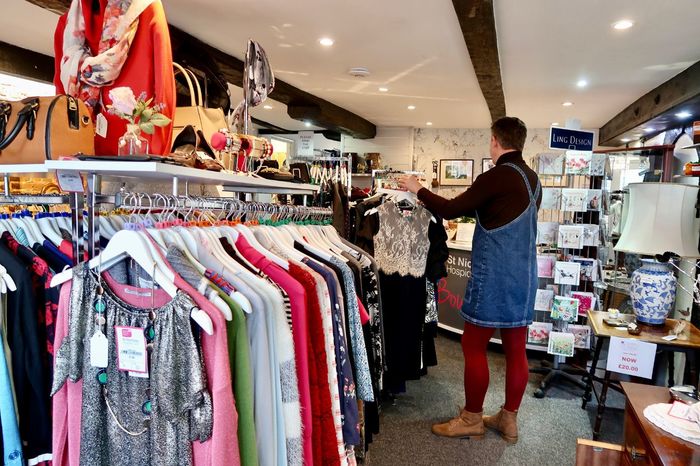The future of clothing lies in ‘Total Ethics Fashion’
Elsie McDowell explores the pioneering work of Emma Hakansson towards a fashion industry that values life

Fashion that values humans, animals, and the planet alike - an alien concept to today’s fashion industry, no doubt. Founder and director of Collective Fashion Justice Emma Hakansson is determined to change that, with what she calls ‘total ethics fashion’.
Calling in over Zoom to a Cambridge Climate Society (CCS) event tucked away in Downing, Emma laid her case boldly and clearly: ‘unless you’re a nudist, you probably wear clothes’. This is more than just a witty observation; our clothing is an essential part of our daily lives, but also one of the most polluting. Over the last decade, the environmental and ethical implications of our clothing have become regular conversations - it takes just a quick glance at this newspaper’s fashion articles to see that. Yet, our clothing consumption has continued to grow and our landfills to expand. What has gone so wrong?
“Total ethics fashion is the ultimate goal; it is fashion that values life”
Conversations about fast fashion tend to focus on the individual: how can we make our clothes last longer, or use our consumer power to support the businesses with the best practices? These choices are without a doubt important, but rampant overconsumption, for instance, is partly driven by the lower quality of our clothes. This is precisely why Emma turns to the fashion industry for the solutions, rather than our personal buying habits alone.
Total ethics fashion is the ultimate goal; it is ‘fashion that values life’. When we talk about fast fashion, we often discuss its harms in isolation. When we engage in - valid - critiques of the carbon emissions associated with producing our clothes, it is easy to forget the hands that made them, however far away they may be. We often fall prey to so-called ‘carbon tunnel vision’, where we allow a focus on carbon to obscure the fashion industry’s other harmful practices.

For instance, the fashion industry scores notoriously high when it comes to rates of human trafficking, and worrying low on fair wages. For you to have bought a top on Shein for £5, someone has to have been paid less than that to make it.
Non-human animals also feel the effects of our clothing consumption. As Emma pointed out during the talk, misconceptions about leather in particular as a by-product of the meat industry mean that few people realise that (first hand) leather can act as a subsidy for factory farming. 69% of garments today are made using fossil fuels, many of which are marketed as ‘ethical’ alternatives to animal-derived products. Even so-called ‘natural’ materials are often coated or mixed with synthetic materials, especially plastic, which producers rarely have to disclose. Indeed, this ‘natural fallacy’ obscures the fact that animal-derived products are often some of the most carbon intensive because of the methane emissions associated with livestock.
The rampant deforestation needed to sustain the livestock and crops required for these garments has knock-on effects on biodiversity and the ability of forests to adsorb carbon, too. Also, the sheer amount of clothes being produced means that textiles are increasingly contributing to our methane-emitting landfills.
“For you to have bought a top on Shein for £5, someone has to have been paid less than that to make it”
These harms are as expansive as they are harmful, but that does not mean that there is nothing to be done. If our clothing is to become more ethical it will need to become more expensive to reflect the actual value of our garments. But, as Emma astutely pointed out, ‘if you’re not being paid a living wage, it’s hard to afford clothes made by someone being paid a living wage’.
As long as the fashion industry relies on materials that are ‘inherently harmful, inherently inefficient, and inherently unethical’, as Emma put it, little is going to change. So, what is Collective Fashion Justice calling on the fashion industry to do in order to value the humans, non-humans, and the planetary resources required to sustain it? Some solutions are governmental, such as improved anti-greenwashing legislation and subsidies that benefit ‘next-generation’ materials. Others involve scientific advances in the production of said new materials, such as those made from mushrooms or mango.
Some of the burden does still fall on us as consumers, because the Earth cannot sustain the production and disposal of even the most sustainable materials at the rate at which we are currently consuming them. Until the fashion industry embraces a Total Ethics approach, extending the life cycle of our clothes through proper care and mending, buying as few new clothes as possible and, where necessary, buying second-hand, will continue to be the best that we as individuals can do. And, sign the total ethics fashion manifesto, which calls on the industry to recognise that it must ‘place life before profit’ and ‘boldly work towards incremental yet radical and meaningful transformation’.
Want to share your thoughts on this article? Send us a letter to letters@varsity.co.uk or by using this form
 News / Uni offers students £55k in payouts31 October 2025
News / Uni offers students £55k in payouts31 October 2025 News / Uni error forces deeper spending cuts31 October 2025
News / Uni error forces deeper spending cuts31 October 2025 News / College rowing captains narrowly vote to exclude trans women31 October 2025
News / College rowing captains narrowly vote to exclude trans women31 October 2025 News / Students launch women’s society excluding trans women31 October 2025
News / Students launch women’s society excluding trans women31 October 2025 News / Students allowed to use AI, says new uni guidance31 October 2025
News / Students allowed to use AI, says new uni guidance31 October 2025










